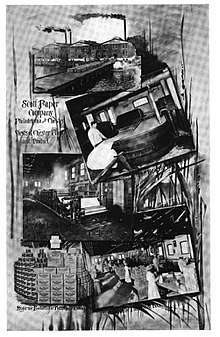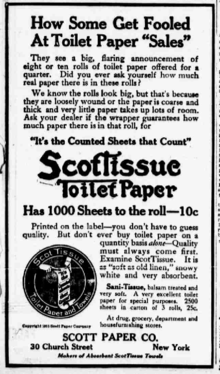Scott Paper Company
The Scott Paper Company was the world's largest manufacturer and marketer of sanitary tissue products with operations in 22 countries. Its products were sold under a variety of well-known brand names, including Scott Tissue, Cottonelle, Baby Fresh, Scottex and Viva. Consolidated sales of its consumer and commercial products totalled approximately $3.6 billion in 1994.[1]
 | |
| Industry | Personal care |
|---|---|
| Fate | Acquired by Kimberly Clark |
| Founded | Philadelphia, Pennsylvania (1879) |
| Products | Toilet paper, paper towels |
| Parent | Kimberly Clark |
The company was acquired by the Kimberly-Clark Corporation in 1995.[2]
History


Scott Paper was founded in 1879 in Philadelphia by brothers E. Irvin and Clarence Scott, and is often credited as being the first to market toilet paper sold on a roll. They began marketing paper towels in 1907, and paper tissues in the 1930s.[3]
In 1927, Scott purchased a Nova Scotian pulp mill, and thus began a long series of acquisitions. It joined with The Mead Corporation in 1936 to form Brunswick Pulp & Paper Company, which used their pulp mill in Georgia to supply both Mead and Scott. The company then bought mills in New York and Wisconsin, and during the 1950s Scott merged with Southview Pulp Company and Hollingsworth & Whitney Company, which provided timberlands and mills in Washington, Alabama, and Maine.[4]
Scott enjoyed success throughout the 20th century due to their advertising methods, which can be traced back to Arthur Scott, the son of E. Irvin Scott.
In December 1994, Scott sold its printing and publishing papers business, consisting of its wholly owned subsidiary, S.D. Warren, for approximately $1.6 billion.[1]
Acquisition by Kimberly-Clark
In 1995 Scott Paper was acquired by Kimberly-Clark,[5] which continues to use the Scott brand. Scott Paper Limited, its subsidiary in Canada, was sold and became Kruger Inc. As part of the sale of the company, the Baby Fresh baby wipes brand was sold to Procter & Gamble and is now sold under the Pampers brand.[6] The Scotties facial tissue brand was sold to Irving Tissue.[7] Other divested brands include Cut-Rite which was sold to Reynolds Metals in 1986.[8]
Headquarters
The headquarters of the company for many years was located at International Plaza (known then as Scott Plaza) in Tinicum Township, Delaware County, Pennsylvania, in Greater Philadelphia. The complex at that time consisted of three buildings known as Plaza I, Plaza II, and Plaza III. Plaza I was completed in 1961. Plaza II was completed after 1961. Plaza III was completed in 1969.[9] The complex was constructed for the purpose of serving as Scott's headquarters.[10]
See also
References
- EDGAR - Company Filings (1995-11-08). "Registration Statement under the Securities Act of 1933". Business of Scott. U.S. Securities and Exchange Commission. Retrieved 2014-11-07.
- Collins, Glenn (1995-07-18). "Kimberly-Clark to Buy Scott Paper, Challenging P.& G." The New York Times. Retrieved 2014-11-06.
- "About Us". Scott Products. Kimberly-Clark. Retrieved 2014-11-06.
- "History of Scott Paper Company – FundingUniverse". Fundinguniverse.com. Retrieved 2018-08-11.
- "Kimberly-Clark Completes $9.4-Billion Purchase of Scott Paper: Firm likely to cut jobs, take hefty charge and sell several units".
- Bloomberg Business News (1996-05-24). "P.& G. to Acquire a Baby Products Unit of Scott". The New York Times. Retrieved 2014-11-06.
- "Company News: Kimberly-Clark Moves to Satisfy Antitrust Concerns". The New York Times. 1996-06-05. Retrieved 2014-11-06.
- "Wax Paper". Reynolds Kitchens. Reynolds Consumer Products LLC. Retrieved 2014-11-07.
- "United States Environmental Protection Agency Region III Statement of Basis former Scott Paper Research Facility Tinicum Township, PA EPA ID No. PAD001287879 Prepared by Office of Pennsylvania Remediation Land and Chemicals Division." (Archive) Environmental Protection Agency. Section 2: Facility Background p.2. August 2012. Retrieved on September 6, 2012.
- Kostelni, Natalie. "Old Scott Paper HQ for sale." Philadelphia Business Journal. September 16, 2002. 1. Retrieved on September 6, 2012.
